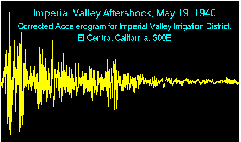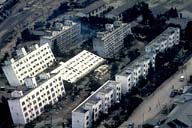
British Columbia Institute of Technology
Department of Civil Engineering
Unit 2: Earthquake Effects
Characteristics of Earthquakes
General Effects of Earthquakes
Objectives
Upon successful completion of this unit students will be able to:
- describe the effects of earthquakes in terms of human and economic losses and illustrate with few examples;
- explain the characteristics of earthquakes and identify typical earthquake representations (records) used for earthquake engineering studies and design;
- explain the four main types of damaging effects of earthquakes, and
- explain two important terms related to building reaction to earthquakes i.e. inertial forces and the fundamental period of vibration.
Background
Earthquakes are natural disasters of a generally unpredictable nature. In spite of considerable efforts made towards improving the understanding of these natural disasters and protecting built environment from their effects, earthquakes still cause huge human and economic losses; this is true both for highly industrialized and lesser developed countries. Recent examples of earthquakes which caused significant economic losses are the 1994 Northridge (California) earthquake which killed 57 people and caused the economic loss of approximately $40 billion, and the 1995 Great Hanshin (Kobe, Japan) earthquake that killed more than 5,000 people and caused the economic loss of $110 billion. Some other recent earthquakes caused smaller economic losses, however these events caused a significantly larger number of fatalities, e.g. the recent 1999 Izmit (Turkey) earthquake caused 15,000 deaths and the 1993 Killari (India) earthquake caused 10,000 deaths. Also, September 1999 Chi-Chi (Taiwan) earthquake caused over 2,400 deaths and the economic loss of over $30 billions. Most of the human and economic losses in these earthquakes were due to the collapse of buildings and other man-made structures.

Collapse of a residential building in the 1995 Kobe (Japan) earthquake (magnitude 7 on the Richter scale)
A general study of earthquakes includes: consideration of the nature of ground faults, the propagation of shock waves through the earth mass, the specific nature of recorded major quakes, etc. However, the material presented here is focused mainly on the basic concepts of designing the buildings capable to resist earthquake effects, which is a scope of earthquake engineering, the branch of engineering devoted to mitigating earthquake hazards.
 Earthquake
engineering covers the investigation and solution of the problems created
by damaging earthquakes, and consequently the work involved in the practical
application of these solutions, i.e. in planning, designing, constructing
and managing earthquake-resistant structures and facilities.
Earthquake
engineering covers the investigation and solution of the problems created
by damaging earthquakes, and consequently the work involved in the practical
application of these solutions, i.e. in planning, designing, constructing
and managing earthquake-resistant structures and facilities.
In the following section we are going to describe the characteristics of earthquakes of relevance to earthquake engineering studies.
Characteristics of Earthquakes
A major earthquake ![]() is usually rather short in duration, often lasting
only a few seconds and seldom more than a minute or so.
is usually rather short in duration, often lasting
only a few seconds and seldom more than a minute or so.
In general, during a quake there are usually one or more major peaks of magnitude of motion. These peaks represent the maximum effect of the quake.
Although the intensity of the quake is measured in terms of the energy release at the location of the ground fault, the critical effect on the given structure is determined by the ground movements at the location of the structure. The effect of these movements is affected mostly by the distance of the structure from the epicenter, but they are also influenced by the geological conditions directly beneath the structure and by the nature of the entire earth mass between the epicenter and the structure.
Modern recording equipment and practices provide us with representations of the ground movements at various locations, thus allowing us to simulate the effects of major earthquakes. One of the most common earthquake representations is acceleration of the ground in one horizontal direction plotted as a function of elapsed time; a typical acceleration record of an earthquake is shown on the figure below. For use in physical tests in laboratories or in computer modeling, records of actual quakes may be "played back" on structures in order to analyze their responses.

Acceleration vs. time record of the 1940 Imperial Valley, California earthquake at the El Centro Station (this is one of the most popular earthquake records)
Although it may seem like a gruesome way to achieve it, we advance our level of competency in design every time there is a severe earthquake that results in some major structural damage to buildings. Engineering societies (e.g. Earthquake Engineering Research Institute of Oakland, California) and other groups routinely send investigating teams to the sites of major quakes to report on the effects on buildings in the area. Of particular interest are the effects on recently built structures, because these buildings are, in effect, full-scale tests of the validity of our most recent design techniques. Each new edition of the building codes reflects some of the results of this cumulative growth of knowledge gained from the latest disasters.
This section has been developed based on the by Ambrose's and Vergun's book (see Resources section for the complete reference).
General Effects of Earthquakes
The ground movements caused by earthquakes can have several types of damaging effects. Some of the major effects are:
- Ground shaking, i.e. back-and-forth motion of the ground, caused by the passing waves of vibration through the ground;
- Soil failures, such as liquefaction and landslides, caused by shaking;
- Surface fault ruptures, such as cracks, vertical shifts, general settlement of an area, landslides, etc.
- Tidal waves (tsunamis), i.e. large waves on the surface of bodies of water that can cause major damage to shoreline areas.
A dramatic illustration of several building collapses (entire buildings tilted over) induced by soil failure (liquefaction) in the 1964 Niigata (Japan) earthquake is shown in the figure below.

Additional damage can be caused by fires or gas explosions started by the shaking or by flooding from failures of dams, etc.
Although all these possible effects are of concern, structural engineers are directly concerned about the effects of ground shaking to building structures.
| The main task of structural engineers as related to earthquake engineering is to provide the structures they design with dynamic stability (general resistance to ground shaking) and some quantified resistance to seismic forces (the required level of seismic resistance for various building structures is usually prescribed by building codes). |



